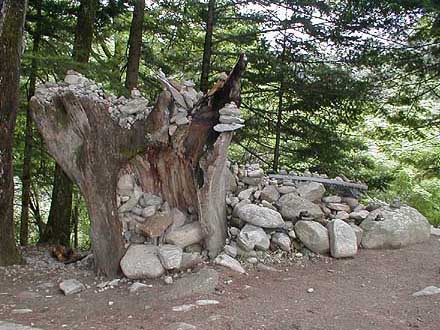

|
Korea is, or at least was, a perfect example of how people of different religions can get on well together.
Their religious heritage
blends
Buddhism,
Confucianism, and
Shamanism. Actually, the largest category in Korean faith today is NOTA -- "None of the Above." In a 2005 survey, about 47% of Koreans said they didn't follow any particular religion. Buddhism claimed about 23% and Christianity about 30%. When Margaret was teaching in 2000, these percentages were 49%, 24%. and 26% respectively. Korea's constitution gives Korea a secular government, and guarantees freedom of religion. Even though they were practicing Catholics, former presidents Kim Dae Jung and Roh Moo-hyun (both politically center-left) were scrupulously fair about keeping Christianity and Buddhism balanced in Korea. They made sure that Korean workers got the same time off for Christmas and Buddha's Birthday, for example. It also became more of a challenge for foreign Christian missionaries to get visas, since they'd already been so successful for so long. (Korean Christians tend toward evangelical flavor.)Korea's next president? Not so much. Lee Myung-bak held the office from 2008 to 2013. Even before he was elected president, he upset Korea's Buddhists when he "dedicated Seoul to the Lord." So it's no surprise that Buddhists were keeping a close watch on the newly installed president for signs of bias. They didn't have long to wait. In just his first few months, Lee picked an overwhelmingly Christian cabinet. He incensed Buddhists when the Seoul police stopped the leader of their largest order at the Jogye temple gate and searched his car. He infuriated them when his transportation ministry erased Buddhist temples from the electronic public transit maps. By the summer of 2008, Korea's famously calm Buddhists had taken to the streets. Lee stirred up still more controversy in 2011 when he knelt at a prayer breakfast. It's hard to argue that Lee's speech and actions didn't drove a wedge between the two religions. His policies seemed to make Christians, especially evangelical Protestants, more aggressive toward Buddhists. Probably the most shocking example of this was the minister -- yes, a minister! -- who vandalized a Buddhist temple in 2012. If Korean Christians were expecting to win converts this way, it doesn't seem to have worked too well. I haven't seen any more recent percentages than the ones above, but there were reports of Protestants walking away from their faith, some defecting to Catholicism, some to Buddhism. In February of 2013 Lee's term was up and Korea's new president, Park Geun-hye, took over. Politically speaking, she's about as conservative as Lee was. Both are members of the right-wing Saenuri Party, formerly called the Grand National Party. But when it comes to religious policy, Park's closer to center-left presidents Kim Dae Jung and Roh Moo-hyun. Both of them were Catholic. Park was too. Or was she? Actually, she was a pretty private person and didn't seem to talk much about her personal faith. But, religiously speaking, she may have helped Korea smooth over its differences. She went to a Catholic university and was baptized there. Her mother was a devout Buddhist. She reportedly had a long list of Protestant friends. And she didn't go to church, which aligned her with that Korean majority (non-)religion, NOTA. Whatever her own faith, or lack thereof, Park seemed to make an effort to treat Korea's major religions equally. Back in 2000, when I first wrote this page, I said that Korea was an example for the rest of the world on how a buffet of beliefs could all get along. It's gotten a bit off track since then, but we'll see how things settle out in the next few years.So what does all that have to do with the picture above? Well, one Korean religion got almost no discussion in all this controversy. I think it deserved some, because aggressive Christian fundamentalists have been up in arms about it for a long time, as you can read here. I'm talking about Shamanism. Shamanism is Korea's ancient religion, a big part of the nation's history, but today it's a tiny sliver of the one-percent religion pie-slice usually labeled "other." Way less than 1% of Koreans would say they actually practice it. That's what they say. But for many Koreans, especially older ones, Shamanism plays a bigger role in their lives than they realize. When they worry about ghosts, or visit a fortune teller to find out the best time to get married or change jobs, or ask a shaman to help them reverse a string of bad luck -- that's Shamanism talking. Shamanism's roots run deep and wide in Korea, and in some ways they intertwine with Buddhism's. How so? When Buddhists arrived from China in 372, they very reasonably and sensibly borrowed some rituals and principles from Shamanism. This isn't so different from what early Western Christians did with our old pagan rituals -- such as taking over the Winter Solstice revel and calling it Christmas. Our photo shows you one of Shamanism's outposts in modern Korean life. Shamanists believe that things have spirits just as people do. Yes, even rocks do. Apparently concentrating lots of these spirits in one place makes them happy, because Korean tradition says that adding a rock to the pile will bring you good luck. Judging from the number and size of the rockpiles you see just about everywhere that isn't paved over, there must be lots of lucky Koreans.Be they religious or no, Koreans love their mountain hikes. This photo comes from our walk through part of Odeasan National Park, as good a place as any to try out some of that old time religion.
|